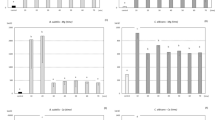Abstract
Bio-related techniques have been proved to be efficient and specific in eliminating impure minerals such as goethite, hematite and kaolinite from aluminum hydroxides in bauxite processing. In this study, the bacterium Paenibacillus polymyxa (P. polymyxa) mediated dissolution and flotation of bauxite were experimentally investigated. To disclose the contribution of adhered bacteria to these two processes, comparative experiments were designed, with one (and the other not) being dialyzed to prevent cells from contacting with bauxite. The results show that all the release rates of Al, Fe and Si are accelerated by the involvement of bacteria during 11 experimental days. More Al, Si and especially Fe are leached out in contact trial than in dialysis trial, and simultaneously, a large amount of Si-enriched flocs are formed. Further analysis indicates that with the adhesion of P. polymyxa and high molecular weight metabolites, Fe minerals are much more dissolvable than kaolinite. However, kaolinite can be floated easily with the mediation of adhered bacteria and metabolites. This study suggests that in bauxite biobeneficiation, sufficient contact between microbes and bauxite can facilitate the elimination of impurities such as iron and silicon.
Similar content being viewed by others
References
Anand P, Modak JM, Natarajan K A (1996). Biobeneficiation of bauxite using Bacillus polymyxa: Calcium and iron removal. Int J Miner Process, 48 (1–2): 51–60
Barker W W, Welch S A, Chu S, Banfield J F (1998). Experimental observations of the effects of bacteria on aluminosilicate weathering. Am Mineral, 83: 1551–1563
Bromfield S M (1954). Reduction of ferric compounds by soil bacteria. J Gen Microbiol, 11 (1): 1–6
Buss H L, Lüttge A, Brantley S L (2007). Etch pit formation on iron silicate surface during siderophore-promoted dissolution. Chem Geol, 240 (3–4): 326–342
Cheah S F, Kraemer SM, Cervini-Silva J, Sposito G (2003). Steady state dissolution kinetics of goethite in the presence of desferrioxamine B and oxalate ligands: Implications for the microbial acquisition of iron. Chem Geol, 198 (1–2): 63–75
Deaton B C, Balsam W L (1991). Visible spectroscopy-a rapid method for determining hematite and goethite concentration in geological materials. J Sediment Res, 61: 628–632
Deo N, Natarajan K A (1999). Role of corundum-adapted strains of Bacillus polymyxa in the separation of hematite and alumina. Miner Metall Process J, 16 (4): 29–34
Deo N, Natarajan K A (1998). Studies on interaction of Paenibacillus polymyxa with iron ore minerals in relation to beneficiation. Int J Miner Process, 55 (1): 41–60
Ehrlich H L (1992). Metal extraction and ore discovery. In: Lederberg J,Ed. Encyclopedia of Microbiology 3. San Diego: Academic Press, 75–80
Forsythe J H, Maurice P A, Hersman L E (1998). Attachment of a Pseudomonas sp. to Fe(III)-(hydr) oxide surfaces. Geomicrobiol J, 15 (4): 293–308
Grantham M C, Dove P M (1996). Investigation of bacterial-mineral interactions using Fluid Tapping Mode™ Atomic Force Microscopy. Geochim Cosmochim Acta, 60 (13): 2473–2480
Groudev S N (1999). Biobeneficiation of mineral raw materials. Minerals and Metallurgical Processing Journal, 16 (4): 19–28
Groudeva V I, Groudev S N (1983). Bauxite dressing by means of Bacillus circulans. Travaux ICSOBA, 13 (18): 257–263
Hersman L, Lloyd T, Sposito G (1995). Siderophore-promoted dissolution of hematite. Geochim Cosmochim Acta, 59 (16): 3327–3330
Kubicki J D, Schrotter L M, Itoh M J, Nguyen B N, Apitz S E (1999). Attenuated total reflectance Fourier-transform infrared spectroscopy of carboxylic acids adsorbed onto mineral surfaces. Geochim Cosmochim Acta, 63 (18): 2709–2725
Kraemer S M (2004). Iron oxide dissolution and solubility in the presence of siderophores. Aquat Sci, 66 (1): 3–18
Liermann L J, Barnes A S, Kalinowski B E, Zhou X Y, Brantley S L (2000). Microenvironments of pH in biofilms grown on dissolving silicate surfaces. Chem Geol, 171 (1–2): 1–16
Lower S K, Tadanier C J, Hochella M F Jr (2000). Measuring interfacial and adhesion forces between bacteria and mineral surfaces with biological force microscopy. Geochim Cosmochim Acta, 64 (18): 3133–3139
Lower S K (2005). Directed natural forces of affinity between a bacterium and mineral. Am J Sci, 305 (6–8): 752–765
Maurice P A, Lee Y J, Hersman L E (2000). Dissolution of Alsubstituted goethites by an aerobic Pseudomonas mendocina var. bacteria. Geochim Cosmochim Acta, 64 (8): 1363–1374
Natarajan K A, Deo N (2001). Role of bacterial interaction and bioreagents in iron ore flotation. Int J Miner Process, 62 (1–4): 143–157
Persson P, Axe K (2005). Adsorption of oxalate and malonate at the water-goethite interface: molecular surface speciation from IR spectroscopy. Geochim Cosmochim Acta, 69 (3): 541–552
Santhiya D, Subramanian S, Natarajan K A (2002). Surface chemical studies on sphalerite and galena using extracellular polysaccharides isolated from Bacillus polymyxa. J Colloid Interface Sci, 256 (2): 237–248
Vasan S S, Modak J M, Natarajan K A (2001). Some recent advances in the bioprocessing of bauxite. Int J Miner Process, 62 (1–4): 173–186
Welch S A, Ullman W J (1993). The effect of organic acids on plagioclase dissolution rates and stoichiometry. Geochim Cosmochim Acta, 57 (12): 2725–2736
Wiederhold J G, Kraemer S M, Teutsch N, Borer P M, Halliday A N, Kretzschmar R (2006). Iron isotope fractionation during protonpromoted, ligand-controlled, and reductive dissolution of Goethite. Environ Sci Technol, 40 (12): 3787–3793
Wightman P G, Fein J B (2004). The effect of bacterial cell wall adsorption on mineral solubilities. Chem Geol, 212 (3–4): 247–254
Yoshida T, Hayashi K, Ohmoto H (2002). Dissolution of iron hydroxides by marine bacterial siderophore. Chem Geol, 184 (1–2): 1–9
Zinder B, Furrer G, Stumm W (1986). The coordination chemistry of weathering:. II. Dissolution of Fe(III) oxides. Geochim Cosmochim Acta, 50 (9): 1861–1869
Author information
Authors and Affiliations
Corresponding author
Rights and permissions
About this article
Cite this article
Zhou, Y., Wang, R., Lu, X. et al. Roles of adhered Paenibacillus polymyxa in the dissolution and flotation of bauxite: a dialytic investigation. Front. Earth Sci. China 4, 167–173 (2010). https://doi.org/10.1007/s11707-010-0021-9
Received:
Accepted:
Published:
Issue Date:
DOI: https://doi.org/10.1007/s11707-010-0021-9




